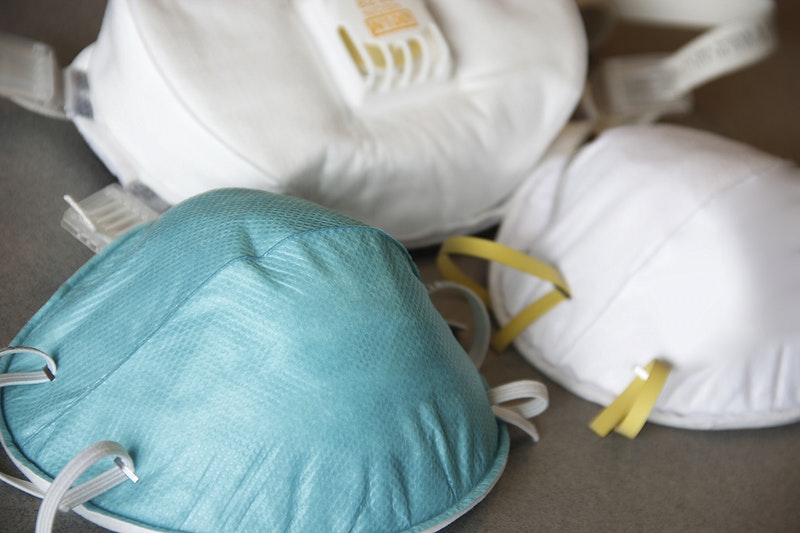Georgetown Physicist Helps Create New N95 Mask Decontamination Guidelines
A team of 60 scientists, engineers, students and clinicians that includes a Georgetown physicist yesterday unveiled N95decon.org, a website that synthesizes the scientific literature about mask decontamination.
As health workers and first responders attempt to stem a pandemic without adequate protective gear, they are forced to consider decontaminating and reusing N95 masks to safeguard those whose jobs expose them to the virus that causes COVID-19.
Daniel Blair, an associate professor in Georgetown’s Department of Physics and Institute for Soft Matter, is part of the team helping to create a set of best practices for the decontamination and reuse of N95 Personal Protection Equipment, known as PPE.
Critical Need

“We realized that there was a critical need for clinicians on the front line to have the most accurate and well-researched data available to them when considering reusing N95 masks,” Blair says. “Our overarching goal is that this work provides a guide that is based in the most up-to-date science for the people that need protection in situations where resources are scarce.”
Team members, which include scientists from Stanford, Harvard, the University of California, Berkeley and the University of Chicago, scoured hundreds of peer-reviewed publications over the last few weeks and held continuous online meetings to review studies of decontamination methods.
These methods previously have been used to inactivate previous viral and bacterial pathogens, and the team assessed the potential for these methods to neutralize the novel SARS-CoV-2 virus that causes Covid-19.
Citing Pros and Cons
The goal of the new website is to provide overwhelmed health officials who don’t have time to study the literature themselves, with reliable, pre-digested scientific information about the pros and cons of three different decontamination methods the team believes offer the best options should local shortages force a choice between decontamination, reuse or going unmasked.
The methods are heat and humidity; a specific wavelength of light called ultraviolet C (UVC); or treatment with hydrogen peroxide vapor.
The scientists did not endorse any one method but instead sought to describe the circumstances under which each technique could inactivate the virus provided rigorous procedures are followed.
The team determined that devices that rely on heat, for example, could be used under specific temperature, humidity and time parameters. With UVC devices – which emit a particular wavelength and energy level of light – considerations involve ensuring masks are properly oriented to the light so their entire surfaces are bathed in sufficient energy.
“While there is no perfect method for decontamination of N95 masks, it is crucial that decision-makers and users have as much information as possible about the strengths and weaknesses of various approaches,” said Manu Prakash, an associate professor of bioengineering at Stanford who helped coordinate the volunteer team. “Manufacturers currently do not recommend N95 mask reuse. We aim to provide information and evidence in this critical time to help those on the front lines of this crisis make risk-management decisions given the specific conditions and limitations they face.”
CDC Fact Sheet
The good news is that the hydrogen peroxide vapors method has the potential advantage of decontaminating masks in volume, as the U.S. Food and Drug Administration has certified certain vendors to offer hydrogen peroxide vapor treatments on a large scale.
As the team unveiled the N95 decon website, the U.S. Centers for Disease Prevention and Control released a data-driven fact sheet and detailed overview for implementing each of these recommended methods.
N95decon.org will help facilitate the safe and rapid deployment of these emergency measures by pointing decision-makers to sources of reliable and detailed how-to information provided by organizations, institutions and commercial services.
Making Informed Decisions
The researchers stressed that decontamination does not solve the N95 shortage, and expressed hope that new masks be made available in large numbers as soon as possible, so healthcare workers and first providers can be issued fresh protective gear whenever needed.
Team members have pledged to continue working together to update the N95decon.org website as new information becomes available, and to coordinate their research to plug the gaps in current knowledge and avoid duplication of efforts.
“The scientific volunteers who made this happen came together in this time of crisis to help workers and administrators make informed decisions about N95 decontamination and standard operating procedures based on their own specific circumstances,” said Hana El-Samad, a professor of biochemistry and biophysics at the University of California, San Francisco Medical Center in a joint statement the team issued in unveiling the website.
-by Shelby Roller (G’19)
